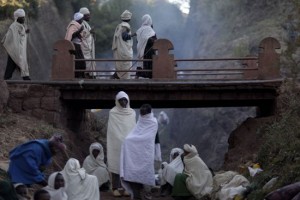Voice of Ethiopia: A solo exhibition of photographs by Atalia Katz
 ZONE: CONTEMPORARY ART is proud to present the gallery’s first photographic exhibition, “Voice of Ethiopia,” a solo premier exhibition of Israeli photographer Atalia Katz. The exhibition is on view April 8 to 30, 2010.
ZONE: CONTEMPORARY ART is proud to present the gallery’s first photographic exhibition, “Voice of Ethiopia,” a solo premier exhibition of Israeli photographer Atalia Katz. The exhibition is on view April 8 to 30, 2010.
Ethiopia is home to historically important communities of Christians, Jews, and Muslims, preservers of ancient ceremonies and traditions within the complex patchwork of African cultures. Many of Katz’s images are steeped in an aura of Biblical antiquity. Dramatically lit rites have a Rembrantesque chiaroscuro. In one panoramic photograph, a procession of worshippers rims a man-made quarry that houses a subterranean church. The roof is a squared-off cross, an ancient Ethiopian symbol that represents the powerful intersection of heaven and earth.
“Voice of Ethiopia” also documents the life of Ethiopian Jews, considered by many to be one of the lost tribes of Israel. The Beta Israel community includes 8,700 people now waiting in the city of Gondar to emigrate, joining the more than 120,000 Ethiopians already living in Israel. Katz’s photographs of the makeshift, metal-hut synagogues of the transit camps reveal vital centers of faith and social life. A grid of nine photographs spotlights the religious rituals and daily experience of this unique cultural enclave. A video on view in the gallery offers an opportunity to experience the dynamic music and dance of their ceremonies. In honor of Ethiopian Jews, ZONE: CONTEMPORARY ART is publishing a limited-edition catalogue, The BOX, which includes selected artist-signed photographs, along with the director’s statement, the artist’s statement and biography. On a pragmatic level, our goal is to raise awareness about the specific group of 8,700 Ethiopian Jews. A portion of the proceeds will go to helping them to relocate.
Even as we become more aware of the extraordinary cultural value of these isolated groups, we recognize our universal humanity. Katz’s striking portraits transcend ethnographic and anthropological concerns to present a gallery of individuals: community elders with worn, timeless faces, young people with a contemporary edge, and vibrant children. Slowly building up trust with her subjects, Katz let us gaze into their eyes; we feel a connection that obliterates distance.
She contextualizes these empathetic portraits with scenes of different Ethiopian environments—landscapes, urban settings, domestic interiors. Ancient and modern are juxtaposed. White-robed figures would not have been out of place a millennium ago; a hunter strides across the desert like his ancient counterpart in an Egyptian wall painting. But people also wear contemporary synthetic fabrics and athletic shoes.
The result is a powerful mosaic. Katz’s photographs stand on their own as works of art. They also open a window into a world that, however unfamiliar it may first appear, resonates with our deepest compassion and respect.
Source: http://eventful.com/

Average Rating